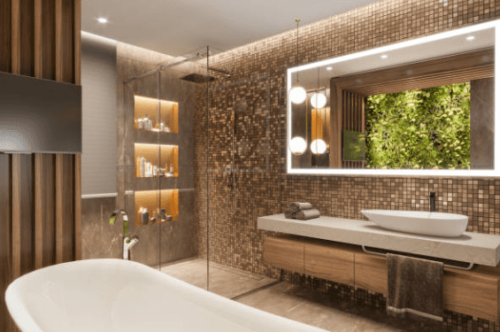If there is no outlet in the bathroom, there are many possible reasons and solutions. First things first, there could be no outlet in your bathroom because of some special safety precautions. Your bathroom is a wet surrounded area, and that poses a significant risk for electrocution than in any other place in your home. For that reason, most bathrooms are set up without sockets around their walls.
It’s good to note that portable appliances like heaters, radios, or hairdryers shouldn’t be used in your restroom, regardless of whether you’ve plugged in from outside your bathroom. Also, note that electric heaters and showers in your bathroom must be fixed by a registered electrician with experience in electrical wiring. Specially designed shaver units are the only exception, but in that case, they can be moved slightly closer but no further than 600mm away from a bath or shower.
3 Possible Solutions If There Is No Outlet in the Bathroom
Suppose you just bought a new bidet, and after you just finished doing the installation, you find out there is no outlet in your bathroom to power it. It can be frustrating, right?
You may notice a light switch in your bathroom and think for a second, could I directly add an outlet from the switch? Well, that may depend on the wiring installation that was done before you moved into that house.

You may presume that there must be an outlet in the opposite room of your bathroom, making it easy for you to fix a new outlet from the bathroom’s switch. But that’s not always the case. The wiring done in your house may be different than you may imagine. Before taking such a tentative step, consider calling a professional.
Below are 3 solutions that we recommend you follow:
The Short-Term Solution If There Is No Outlet in the Bathroom
In most cases, there is usually an electrical outlet near the bathroom door. That makes it possible for you to run extension wires into your bathroom. If there is such an outlet, you can run the cord straight into the room. However, don’t allow extension cords to overload because doing that can cause them to become dangerous.
Extension cords are helpful short-term solutions for infrequently used bathrooms; they are not a permanent solution to the problem. Extension cords can cause electrocution or choking hazard for children, so avoid using them in bathrooms where they could cause injury. Also, discard any cords that become damaged as soon as possible.
The Semi permanent Solution If There Is No Outlet in the Bathroom
Just like in the first case, you can do wiring to connect a power source to your bathroom from another outlet near your bathroom door. However, hide all the wiring that runs from one outlet to another by running wires beneath metal or plastic wire covers.
Wall-mounted wiring is available on the market as a complete system or as individual pieces that include the covers and the mounting brackets. What’s more, the outlets contain mounting boxes that extend from the wall to allow wiring to pass from the outlet below.
The solution is simple because you need only one outlet box to remove the wiring, and the wires from that outlet can be moved easily.
The Permanent Solution If There Is No Outlet in The Bathroom
If your bathroom has no outlets, have regular outlets installed in the room. This method involves the installation of wires that are run directly from your primary breaker box to the several different bathrooms in your house.
Connect a new breaker to an existing breaker box in the home’s electrical system, or continue to wire an outlet found in an adjacent room. Run wires behind drywall to transport electrical current to the various bathrooms in the house.
Remember to install outlet boxes at regular intervals on different wall locations.
What To Consider Before Doing Your Wiring
Some area codes may need homeowners to hire a professional to install new wiring. But if the codes do not apply in your area, it may be necessary to hire a professional to check the location of any new electrical outlets before installing them.
If you’re renting a home and there are no outlets in the bathrooms that you need, you should speak with your landlord to have them added.
FAQs
How much will it cost to install an outlet?
The approximate cost for installing an outlet may range from $125 – $ 175. However, that may differ depending on where you reside. National-wide, expect to spend between $100 – $500 based on the task’s complexity level.
Can I use an extension cord in my bathroom?
It’s not safe to use an extension cord in your bathroom! Water and electricity don’t mix! If you want to use an extension in your bathroom, then ensure it’s plugged into a (GFCI) Ground Fault Circuit Interrupter. Also, don’t overload the extension.
Do I need an Outlet for my bidet?
If you’ve got a bidet, you may consider purchasing the LENCENT 2 prong to 3 prong outlet. It features an input voltage ranging from AC 100V to 125V.

